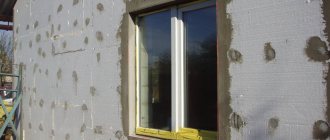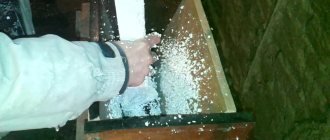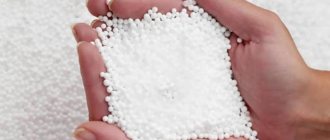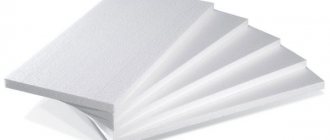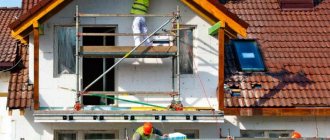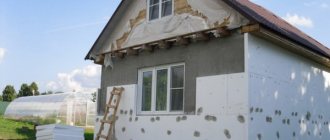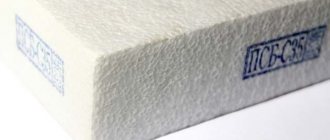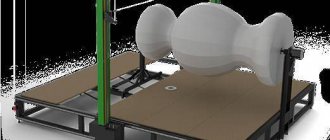In modern construction, both foam plastic and extruded polystyrene foam are used as insulation, and quite often the question arises - which is better: foam plastic or extruded polystyrene foam.
Expanded polystyrene is one of the types of polystyrene foam. But if we talk about each material separately, we can highlight the following advantages of these materials.
Let's summarize
Considering polystyrene foam or expanded polystyrene as a heat insulator, it is definitely impossible to say that it is better. It is necessary to make the choice consciously, based on the specific conditions of the availability of funds, transportation, installation and operating conditions.
If we abstract from the surrounding world, then the analysis carried out will help to draw certain conclusions.
During the comparison, the goal was to show as objectively as possible the disadvantages and advantages of common heat insulators. Help everyone make choices that will not make them regret them over time.
Flammability class
The closest analogue of polyurethane is classified as flammability class G2. This fact can be completely trusted, since the insulator contains nitrogen. But the assurance that polystyrene foam has the same flammability and belongs to the same class is most likely an advertising ploy. According to the generally accepted classification, this insulation is defined as follows:
- NGA, G1 and G2 are non-flammable, slightly and moderately flammable materials; the fire safety characteristics of penoplex can hardly be attributed to these classes;
- G3 - insulation materials with normal flammability parameters; this class includes polystyrene foam with the addition of fire retardant and other components;
- G4 is a conventional polystyrene foam insulation with highly flammable properties.
Some manufacturers claim that they have switched to the production of a brand of penoplex with a G1 flammability class, but this is physically impossible. The first two groups include materials that do not splash into droplets when burning. Polystyrene heat insulator does not have such qualities. Supporting videos of a suspended sample cannot serve as real evidence, since the penoplex droplets flow downwards through natural gravity.
You can compare the flammability of various thermal insulators with polystyrene foam in this video:
Manufacturers
There is fierce competition in the construction market, however, not as many companies are involved in the production of technoplexes as the consumer would like. Let's consider the list of the main suppliers of extruded insulation on the Russian market.
TECHNONICOL. The company is among the TOP 100 largest enterprises in Russia, and has several production lines in the country. The manufactured products attract buyers with a relatively low price and high quality.
URSA. A relatively young brand that appeared on the market in 2003. At the beginning of its development, the company was engaged in the production of mineral wool from fiberglass. After merging with the Spanish company URALITA, lines for the production of extruded polystyrene began operating. Now it is one of the leading European brands, actively developing the Russian building materials market.
RAVATHERM. The trademark belongs to a Belgian company with production lines in the Moscow region. Finished products are subject to multi-stage quality control, so they invariably have high technical characteristics.
It is worth noting that the products of these enterprises have international certificates and are absolutely environmentally safe.
Special purpose insulation
A unique combination of useful properties (high compressive strength and low water absorption) allows the use of EPS in non-standard schemes for other insulation materials. Since the material does not absorb moisture, when making floors on the ground, it can be laid directly on the ground. This solution is not only easier to implement, but also cheaper than laying EPS on a concrete screed. In fact, in this case, a screed is not needed; it is enough to simply level and compact the soil well.
When insulating foundation walls, EPS can be used without additional waterproofing from the outside. This material is one of the most reliable and convenient for insulating the underground part of a building, where it is quite difficult to perform reliable waterproofing of the insulation, and its repair is very expensive.
With the advent of EPS, it became possible to create reliable, serviceable roofs. This material is laid with the reverse order of layers of the roofing pie (inversion roofs). In this case, the waterproofing layer is laid directly on the ceiling, and on top of it are slabs of extruded polystyrene foam, protected on top by paving slabs, terrace covering or gravel. Some manufacturers (Roofmate, etc.) produce special EPS with a protective layer.
Waterproofing in inversion roofs lasts much longer than when it is the topmost layer exposed to ultraviolet radiation and temperature changes. On inverted roofs you can create lawns and even gardens. To do this, geotextiles are laid on top of the insulation boards and a layer of fertile soil is poured, which at the same time serves as a pressure ballast layer.
Safe for me, safe for you
It is impossible not to compare both materials in terms of their impact on the environment and interaction with it. Who to give preference: penoplex or technoplex?
The fire hazard of the materials is the same. They belong to the category of substances that support and spread combustion. When they burn, a gas that is unsuitable for breathing is released into the atmosphere. Because of this, they are not recommended for use as insulation without taking additional measures to ensure fire safety, for example, treating them with thermite.
The chemical and biological activity of these insulation materials is the same due to the use of the same source material: they are not afraid of contact with most building materials and solutions, are not attacked by insects and rodents, do not rot or spread fungus.
Both materials are destroyed under the influence of ultraviolet radiation, so their use without shelter is not recommended.
We evaluate by measuring
Foam plastic differs pleasantly from expanded polystyrene in its variety of linear dimensions.
It is produced in accordance with GOST, which allows the production of foam plastic slabs in lengths from 0.9 to 5 meters. The width varies from 0.5 to 1.3 m. The thickness can be from 20 to 500 mm. When carrying out work, you can save significantly by ordering slabs of the required size from the manufacturer.
Manufacturers of expanded polystyrene are more conservative in this matter. Sheets are produced in widths of 0.6 m, lengths of 1.2 and 2.4 m. Product thicknesses can be 20, 30, 40, 50, 80, 100 and 150 mm. This does not radically increase the complexity of installation, since any of these materials can be easily cut with a construction knife.
What is the difference
If you conduct a comparative analysis between polystyrene foam and extruded polystyrene foam, then at first glance there is not much difference between them. They are made from the same material, but the production technology and density are different. And the main difference between them is the scope of application. Polystyrene is allowed to be used for thermal insulation of a base with a width of 20-30 mm, but the thickness of the foam should be 50 mm. You can read about the pros and cons of polystyrene foam ceiling tiles in the article.
The video shows the difference between polystyrene foam and extruded polystyrene foam:
You may also be interested in learning about the thermal insulation properties of polystyrene foam.
But what is the price of Penoplex insulation for the outside walls of a house and where such material can be used is described in this article.
You can see how the foam ceiling plinth is glued in the video in this article.
But what are the characteristics of extruded polystyrene foam Penoplex that currently exist is described in this article.
Maybe
Insulating a house - what material to choose?
The warm season is exactly the time when it is necessary to solve global construction issues. The most important of which is façade insulation. This question is asked by both apartment owners and private home owners. Both new buildings and houses about 50 years old are insulated. When you have already decided to insulate your house, the question immediately arises, which confuses many, what to choose from these two materials.
Ease of installation
When choosing polystyrene foam and expanded polystyrene, it is recommended to pay attention to one feature of the appearance of the slab of the second candidate. The side surfaces have L, S-shaped protrusions. This results:
- to the formation of a continuous layer of insulation without the formation of cracks and gaps;
- obtaining a more rigid and time-stable thermal insulation field;
- increasing installation speed.
Polystyrene foam has smooth side surfaces, which leads to the need for additional work on the insulated surface. This is expressed by filling the joints with adhesives or polyurethane foam.
The technologies for installing the slabs and the materials used for fastening are identical.
We study the flammability of penoplex
Penolex is a type of thermal insulation material, which is extruded polystyrene foam. Most people, when choosing suitable insulation for their home, are guided by the various characteristics of the material. Many are interested in low price, some prefer ease of installation, and only a small part think about environmental safety and fire resistance. What characteristics does penoplex have? Is it combustible or absolutely non-flammable? It’s strange, but there are a lot of opinions about this indicator, so it’s worth taking a closer look at the fire safety of penoplex.
Pipes with flammability group G1
These pipeline systems have passed specialized tests and have a certificate of flammability group G1 - this ensures the possibility of their use in fire-hazardous premises, basements, risers, warehouses, automatic fire control systems and fire-fighting water supply systems.
Italian silent sewer pipes are the most cost-effective silent sewer!
- Noise absorption - 12 db
- Non-flammability - flammability group G1
- Pressure - adhesive connection - 10 atm
- Non-pressure - socket connection - 3 atm
Installed at the 2018 FIFA World Cup stadiums
Officially approved plastic pipe system in the field of automatic fire extinguishing. Designed specifically for sprinkler systems.
Certified according to established fire safety standards in most countries of the world, as well as by VNIIPO EMERCOM of the Russian Federation for use in fire control systems and fire-fighting water supply systems. Does not require washing, flame retardant.
PPS vs EPPS. What's better?
The peculiarities of our climate zone, as well as high prices for gas and electricity, more and more often lead to the idea that the time has come to seriously address the issue of saving energy resources by insulating the walls of an apartment or country cottage. Moreover, the experience of civilized and developed countries has long proven that energy savings after thermal insulation of walls average from 30 to 60 percent. It is difficult to say a more precise figure, since it depends on many factors, including: the average annual temperature, the material chosen for thermal insulation, the insulation method used, and so on. But one thing is certain - the economic effect of wall insulation is visible in the first year!
Foam plastics: quality characteristics
Depending on the processing technology and composition of the raw materials, foam plastics of various densities and with various strength characteristics are produced.

